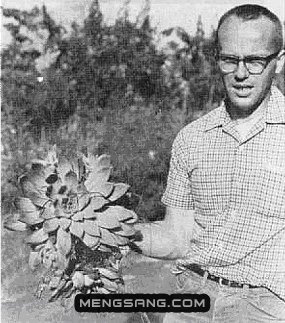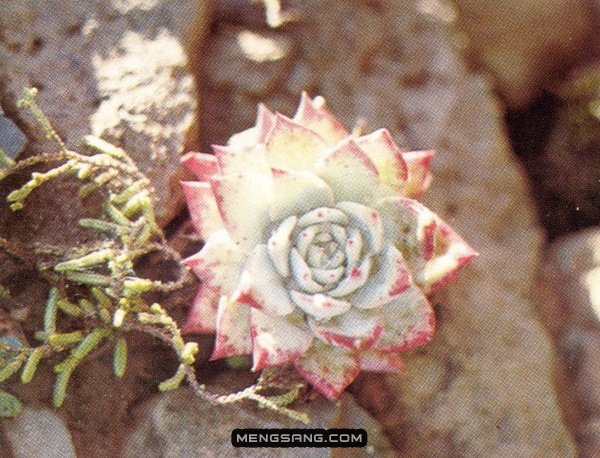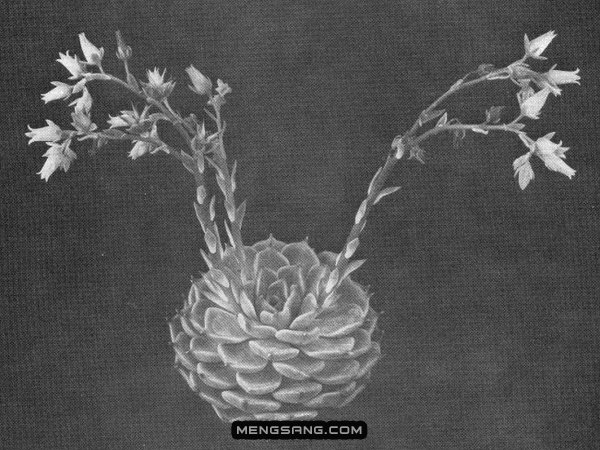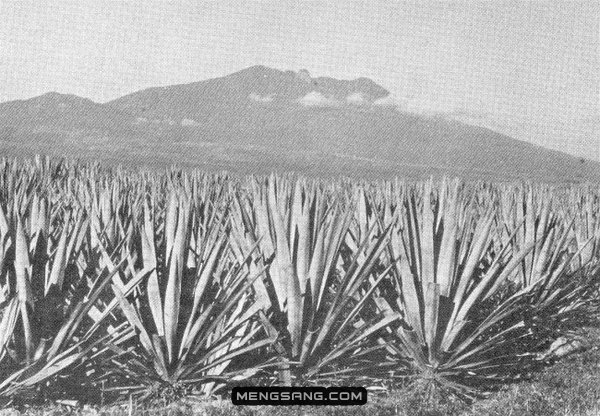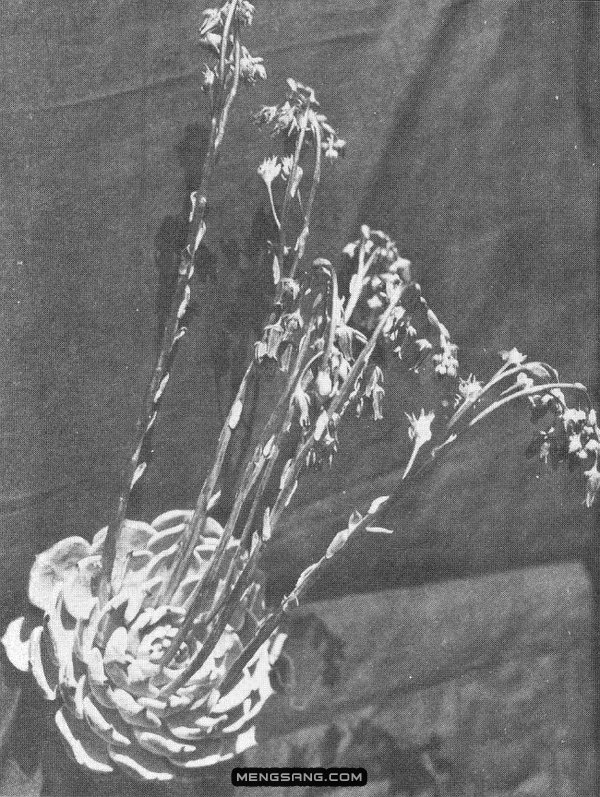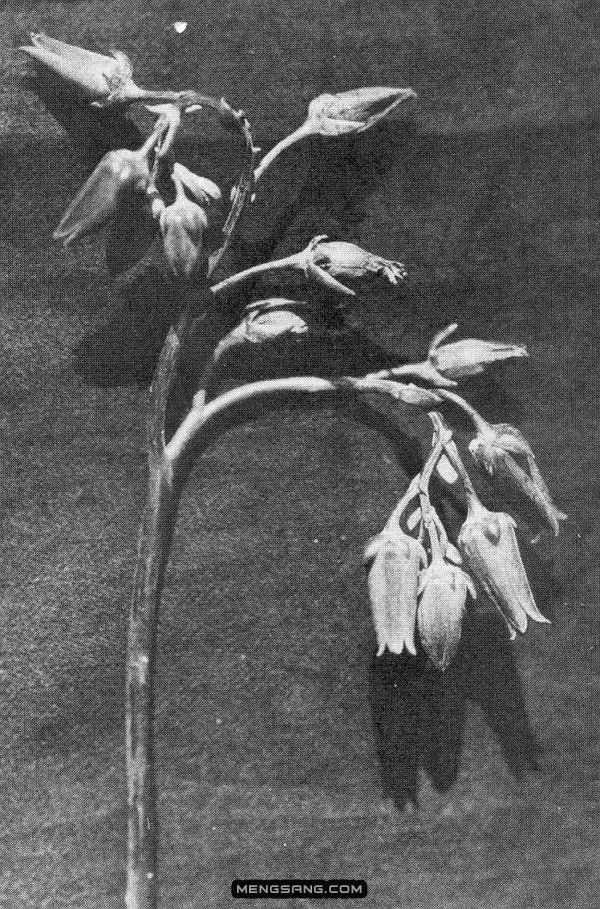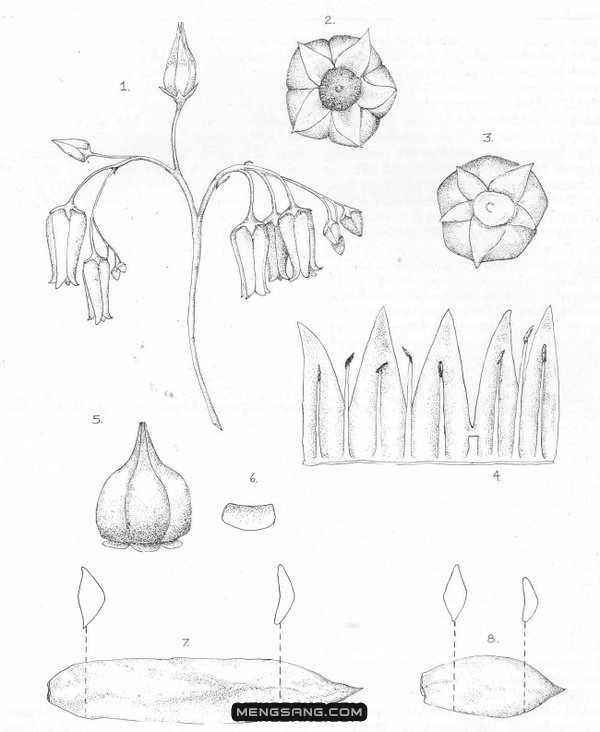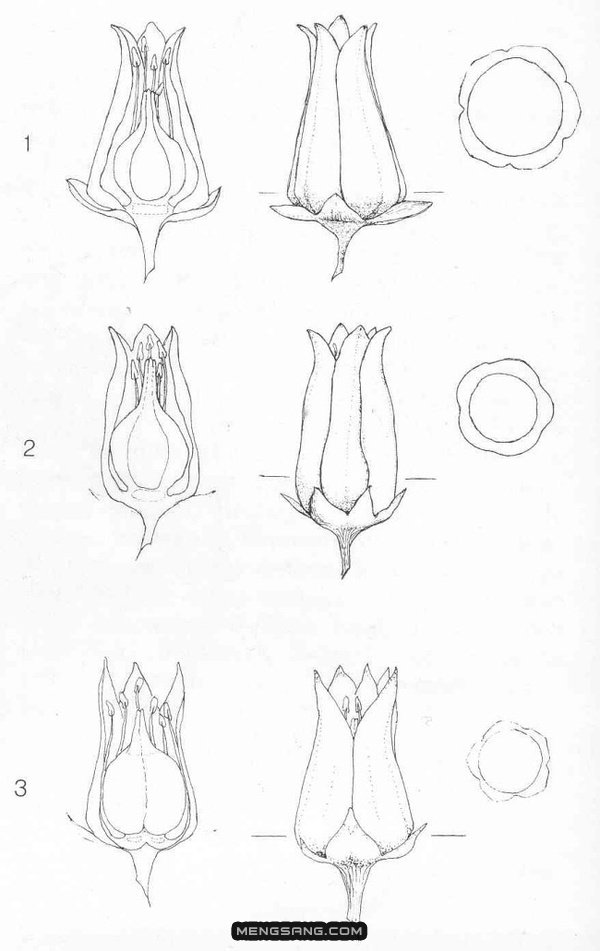A REVISION OF ECHEVERIA COLORATA Walther
卡罗拉、林赛、勃兰特的纠葛史(还有吉娃娃
MYRON KIMNACH
Huntington Botanical Gardens
作者:Myron Kimnach,就职于亨廷顿植物园
(译注:Kimnach是勃兰特、墨西哥女孩、黑爪、红爪、
丽娜莲、木樨景天、魔爪等许多原始种的发表人,也是'Pinky'和
银星等广为人知的园艺品种的培育者,连特玉莲'Topsy Turvy'的名字也是他起的。)
(另:本文写于1980年或更早,其中的资料有一定局限性,仅供参考)
译者:Qiuhan
由于懒,仅提供概要性翻译。译者不懂植物学,欢迎捉虫。
原文:http://crassulaceae.net/echeveriamenu/46-speciesecheveria/609-a-revison-of-echeveria-colorata-engl
The author is indebted to George Lindsay, Reid Moran and Charles Uhl for data and assistance in preparing this paper.
作者在此诚挚感谢George Lindsay、Reid Moran和Charles Uhl,他们为本文提供了数据支持与帮助。
First publication in Cactus & Succulent Journal vol. 52, n°2, 1980.
本文首发于Cactus & Succulent Journal第52期(1980)。
SUMMARY: Discussed are the known collections of Echeveria colorata Walther and a close ally, E. lindsayana Walther, both first described from cultivated plants of unknown origin. Plants recently collected on Volcán de Tequila, Jalisco, are referred to E. lindsayana, a species that differs so little from E. colorata that it is reduced to synonymy under E. colorata var. colorata. A new variety, E. colorata var. brandtii Kimn., is published, as well as descriptions and a key to the two varieties. Photos of all three of these taxa are published for the first time. An insufficiently known species, E. tobarensis Berger, is discussed as the possible valid specific name for these taxa. The closest ally of E. colorata is E. chihuahuaensis von Poelln., native further north in the Sierra Madre Occidental; it differs in its narrower, thinner leaves, shorter flowering stems, denser floral bracts, cincinni in 2 or 3's, and pink petals.
摘要:本文旨在探讨卡罗拉和其近亲林赛,二者的首次发表均基于人工养殖的植株,自然栖息地不明。近来,一些采集自墨西哥Jalisco州Volcán de Tequila的植株被认为是林赛,但由于与卡罗拉的差别及其微弱,林赛已经变为卡罗拉的异名。本文亦公布了另外一个新的变种,勃兰特,同时公开的还有它的描述以及与其他变种的主要特点。卡罗拉、林赛和勃兰特这三者的照片也被首次公开。另外,虽然有关拓跋莲的资料仍不完善,但本文认为它与前三者有紧密的关系。它们的另一个近亲是吉娃娃,原生于更北部的Sierra Madre Occidental。吉娃娃与之的区别在于更窄、更薄的叶子,更短的花梗,更密布的苞叶,花序约2-3(?),花瓣粉色。
1. Echeveria colorata
1. 卡罗拉
In November 1953, the University of California Botanic Garden, Berkeley, received a shipment of Crassulaceae from J.D. Zabaleta of Guadalajara; Mexico. Among the plants was an echeveria he had found growing in gardens in Guadalajara. He also sent several of these plants to Eric Walther. The plant at Berkeley flowered in the succulent house in April 1959, and a specimen of it prepared by Walther became the holotype of E. colorata, published by him in his monograph, "Echeveria," in 1972. The type plant was eventually grown in the ground outdoors at the U.C. Botanic Garden but had died by 1965. It is possible that offsets of this clone still survive in other collections.
1953年墨西哥的J.D. Zabaleta给伯克利分校植物园和Eric Walther寄了点景天。
其中有一个开花了,Walther叫它卡罗拉,1972年发表。
这棵卡罗拉露养在加利福尼亚大学植物园,死于1965年,但它的无性系后代可能至今还存活在其他地方。
In 1968 Fred Boutin and Fred Brandt of the staff of the Huntington were exploring for plants southwest of Guadalajara. In a garden in Tapalpa they found plants of E. colorata which they were told came from the mountains west of Tapalpa. I also saw these plants when visiting Tapalpa with Boutin in 1970. They are so similar to the type collection that they are probably of the same clone. Supporting this is the fact that both collections are infested with a virus that discolors and distorts the leaves; though unrecorded in the literature and as yet unidentified, this virus frequently attacks cultivated plants of Echeveria and Pachyphytum. E. colorata has not been figured in the literature, and photos of the Tapalpa collection are therefore presented here (figs. 2 & 3). In his key, Walther (1.c. 80) stated that E. colorata was also native to Michoacán, but this is mentioned nowhere else in the literature and no specimens so cited are in the herbarium of the California Academy of Sciences, where Walther worked extensively.
1968年,亨廷顿植物园的工作人员Fred Boutin和Fred Brandt来到Guadalajara州的西南部地区探寻植物。
在Tapalpa的一座花园里,他们找到了很多卡罗拉,并得知这个物种来自Tapalpa以西的山上。
我1970年探访Tapalpa的时候,也亲眼见过这些植株。它们和模式标本太像了,而且都感染了一种会使叶子变色和变形的病毒,很可能是同一无性系。这种病毒并未正式被记入文献,迄今也并未验明正身,但它经常感染
拟石莲属和
厚叶草属的植物。
此前,卡罗拉的照片从未在文献中出现过,因此本文特别奉上Tapalpa一系的照片(图2、3)。
在Walther的概要里,他说过卡罗拉产自Michoacán,但没有其他文献能够佐证这一说法,且Walther长期效劳的 California Academy of Sciences的标本中也没有收录。
本小节大意:卡罗拉的模式标本来自Tapalpa
2. Echeveria lindsayana
2. 林赛(的产地之争)
Closely allied to E. colorata is E. lindsayana Walther, likewise described in "Echeveria" from plants without a recorded native locality. A mystery exists concerning this, for Walther told me in the mid-1950's at the U.C. Botanic
Garden that the original plant of E. lindsayana, as well as E. chihuahuaensis von Poelln., were collected in Chihuahua in 1939 by Robert Craig and George Lindsay. He stated that an Indian had come into their camp at Cerocahui ("Cerocaqui," according to Walther) Chihuahua, carrying in separate hands a flowering plant of each species; this account is repeated by Lindsay (Cact. Succ. Journ. Am. 15:73. 1943.) but there is no mention of more than one species being involved. Charles Uhl tells me that in 1954 he made a chromosome count of a plant of E. lindsayana in Walther's garden and that Walther told him at the time that the plant was either E. chihuahuaensis or E. tobarensis and that Craig and Lindsay had collected it in 1939. Consequently, when Walther gave plants of both collections to the U.C. Botanic Garden in 1954, the locality of Cerocahui was recorded on their accession cards and the same data was repeated in the notes for the same clones offered in the International Succulent Institute listing for 1966 (see Cact. Succ. Journ. Am. 38:128-129) .
Walther那本发表了卡罗拉的书里也描述了与卡罗拉及其近似的另一种植物——林赛,但并没有给出这两个物种的产地。
有趣的是,Walther1950年在加利福尼亚大学的植物园里告诉我,林赛和吉娃娃都是Robert Craig和George Lindsay1939年在吉娃娃州采集到的。他说,他们在Cerocahui(Walther管这里叫"Cerocaqui")宿营的时候,有个印第安人两手分别捧了开花的林赛和吉娃娃来拜访。Lindsay本人也谈起过相似的经历(详见Cact. Succ. Journ. Am. 15:73 1943),但并没说起当地人带来的是两种植物。而Charles Uhl告诉我,1954年的时候他给Walther花园里的一棵林赛检测了染色体数目,但Walther当时声称那棵是吉娃娃或者拓跋莲,而且就是Craig和Lindasy1939年采集到的那株。
随后,Walther在1954年将这两种植物捐赠给了加利福尼亚大学植物园,产地却被记录为Cerocahui。而1966年的International Succulent Institute listing上提供的同一无性系也继承了这个说法(详见Cact. Succ. Journ. Am. 38:128-129)。
Fig. 1. Fred Brandt with the type plant of E. colorata var. brandtii photographed at the type locality.
图1:Fred Brandt和勃兰特的模式标本,摄于模式标本产地。
Fig. 2. E. colorata: var. colorata, Boutin and Brandt 2211, upper left; var. colorata (original collection of E. lindsayana), lower left; var. brandtii, upper right; var. colorata from Volcán de Tequila, lower right.
图2:左上:卡罗拉,Boutin和Brandt的2211批标本;左下:卡罗拉(原林赛);右上:勃兰特;右下:卡罗拉,产地Volcán de Tequila
Fig. 3. E. colorata var. colorata in a garden in Tapalpa, Jalisco, with the African Crassula lycopodioides.
图3:Jalisco州Tapalpa花园中的卡罗拉,旁边是非洲
青锁龙属的若绿。
Fig. 4. E. colorata var. colorata growing on the central peak of Volcán de Tequila.
图4:生长在Volcán de Tequila主峰的卡罗拉。
Fig. 5. E. chihuahuaensis `Ruby Blush', a selection from a population collected in 1967 (Kimnach and Brandt 985) at Cusárare Falls, Chihuahua.
图5:`Ruby Blush',吉娃娃的选育种,是从1967年Kimnach和Brandt第985批标本里选育出来的。这批标本采集自吉娃娃州的Cusárare Falls。
To determine if E. lindsayana was indeed collected in Chihuahua by Craig and Lindsay, I wrote Dr. Lindsay, now Director of the California Academy of Sciences in San Francisco, and his account follows: "On April 1 we camped at a place I called Huastagota, in the Tarahumare country. The next day we dropped into a deep arroyo which had Sedum alamosanum and found a ‘red succulent and an echeveria’. We were out on a mesa by mid day and camped in the evening at a ranch called Refugio. I don't know what the echeveria might have been, but at the time we thought it was possibly E. paniculata. On April 8 we left Choro a little after noon and rode to El Cajon, where we camped. Early the next morning a Tarahumare Indian appeared with some plants, including `an echeveria like elegans' which he had collected from some high peaks nearby. We asked him to collect some more and to meet us at Cerocahui. I do not remember whether there was more than one species of Echeveria, but one I photographed and illustrated in the Journal story, by which time I thought it might be E. cuspidata or E. corderoyi. In any case the Indian brought a number of plants in a sack to Cerocahui and I think more than one kind of echeveria was represented. When he appeared that first morning, though, he had one plant in each hand, which he carried so carefully the flowers were intact and made it possible to take the photograph. I have located the negatives and will have prints made to send to you with this letter [see figs. 8 & 9]. I remember Walther discussing with me the fact that he was naming E. craigiana, which we found April 4, 1939, growing over the edge of the Barranca de Cobre... . He did not mention that he was going to name an Echeveria lindsayana and I assume that his information was that we collected the material on which it was based."
为了探究林赛到底是不是Craig和Lindasy在吉娃娃州发现的,我给Lindsay博士写了信。他说“记不清了,反正印第安人带来不止一种。不过他第一天来的时候,带来的应该是吴钩,Walther压根没提过林赛的事儿。”
For reasons now unknown, Walther changed his mind as to the origin of E. lindsayana when he finally published the species: "While the source of the present item is as yet unknown, I feel certain that ultimately its Mexican habitat will be discovered." Nor did he name the species for Lindsay because he considered him its co-discoverer but rather for "the many services towards a better knowledge of cacti and succulents performed by him."
出于不明原因,Walther后来改口说林赛产地不明,不过以后肯定会被发现的。Lindsay其实也是林赛的发现人之一,所以林赛并不完全是以Lindsay命名的,而是为了感谢林赛对仙肉界做出的卓越贡献。
Fig. 6. Volcán de Tequila above a field of Agave tequilana, The central peak is the lava plug of this long inactive volcano.
图6:Tequila火山的熔岩地貌,全是龙舌兰。
Although it cannot be proven that the original collection of E. lindsayana was not collected in Chihuahua, at least the photo published by Lindsay seems to be that of E. chihuahuaensis. The original clones of both species distributed in 1966 by the ISI are still growing at the Huntington, and that of E. chihuahuaensis more closely matches Lindsay's photo in its heavily farinose and thinner leaves with their more persistent cusps.
没有直接证据表明林赛原产于吉娃娃州,Lindsay照的图片根本就是吉娃娃。
A more likely area of origin for E. lindsayana is Jalisco, where its closest relative, E. colorata, is native. In support of this are plants found by Fred Boutin and me in 1970 when we ascended a recently constructed road to a micro-ondas (microwave) relay station near the summit of Volcán de Tequila, above the town of Tequila, Jalisco, northwest of Guadalajara and some 60 miles north of Tapalpa. Here, at the type locality of the recently described Sedum greggii var. angustifolium Clausen, together with Villadia platyphylla (Fr?d.) Clausen, the echeverias grew on precipitous rocky cliffs (see figs. 6 & 7). In the field the leaves of the seven clones we collected were identical in shape and size to those of the type plants of E. lindsayana, though they have become larger in cultivation. The flowers are more similar to those of E. colorata than to those of the type of E. lindsayana, which have a calyx abruptly narrowing to the pedicel and smaller, more yellowish petals. Such variation is common in Echeveria and I therefore consider the Tequila plants referable to E. lindsayana.
林赛的另一个可能产地是卡罗拉的产地,因为俩很像很像的,那地方就是Tapalpa啦。Fred Boutin和我在Tapalpa以北60公里的地方确实找到了七颗,叶子和林赛一模一样,家养以后体型会变大,但花是卡罗拉的,而不那么像林赛,花瓣更黄。由于这点差异在拟石莲属同物种之间很常见,所以我认为这些植株就是林赛。
It is even possible that Walther's plant of this species was also collected on Volcán de Tequila. This conspicuous volcanic cone looms over the prosperous tequila-producing countryside along the highway from Guadalajara to Tepic. It would have attracted climbers even before the micro-ondas road was built and they would very likely have brought into cultivation plants of this attractively colored species. On the other hand, because of its floral and leaf-size differences, it is more probable that the type collection came from another, though nearby, locality.
很有可能Walther那些个植株也是这地方找到的。这块火山区离Guadalajara蛮近。不过因为叶子的大小和花都不太一样,也许Walther那个模式标本是附近另一地区的植株。
E. lindsayana differs from E. colorata in having slightly wider and more abruptly acuminate leaves. Grown side by side, they are distinguishable (see fig. 2), yet they represent variations commonly found within many species of Echeveria. Accordingly, they are regarded as synonymous in the following revision. Although they were described at the same time, E. colorata is retained as the valid name because it is so descriptive of these colorful plants.
林赛和卡罗拉的区别是,前者的叶子略宽一点,红爪尖更明显。种在一起的话,倒是能分别(比如图2),不过其他拟石莲属同物种之间也有这样的差异存在。所以说,以后这两种就被看成一种吧,卡罗拉是他们有效的名字,因为更符合他们的颜色(colorata拉丁词根意为有颜色的)。
本小结大意:林赛的产地谁也说不清楚,反正和卡罗拉长得很像,而且卡罗拉名字好听,那就都叫卡罗拉吧。
3. Echeveria colorata var. brandtii
勃兰特
In November 1968, on the day before they found E. colorata in Tapalpa, Fred Boutin and Fred Brandt were travelling westward from Laguna de Sayula, Jalisco, toward Tapalpa. Along the first six miles of the steeply ascending road they found such succulents as Fouquieria formosa and Lemaireocereus dumortieri, the latter apparently a first record for Jalisco. Stopping again at 6800', they explored an area dominated by pines and oaks and containing few of the rocks on which Crassulaceae usually thrive.
1968年11月,就在发现卡罗拉之前,Fred Boutin和Fred Brandt正从Jalisco州的Laguna de Sayula往Tapalpa走的时候,在海拔2000多米的地方发现了一块长满了松树和橡树的多岩石地带,是
景天科植物喜欢的栖息地。
It was all the more surprising, then, when Fred Brandt found a large clump of echeveria on one of the few mossy rocks on the slope. The plant was most decorative, with long glaucous leaves heavily suffused with red. Although they searched extensively, they failed to find another plant.
惊喜的是,Brandt找到了一棵巨大的拟石莲属植物,好看得很,叶子光光的、红红的。不过仅此一棵,没有找到别的。
Fig. 7. A reverse view of the central lava peak, with agave fields in the distant valley.
图7:山顶全景,远处的山谷里很多龙舌兰。
On a later trip, in January of 1970, Fred Boutin and I stopped at the same site to search for more plants of the echeveria, but an hour's search of the hillside was unsuccessful. The area was seriously disturbed; a settlement of several native huts was only a few hundred feet away, the area had been cut over for fire-wood, and much erosion was evident. Perhaps the original colony of plants had been destroyed by man or the specimen we found had been planted there by the natives.
后来呢,1970年1月,我和Boutin又想去那里找拟石莲,但找了很久都没成功。这一片受到了很厉害的人为干扰,有一些当地人的小屋就在几码之外,树都被砍了生火,地貌受到严重侵蚀。也许这种植物虽然原产于此,但野生植株已经都被人毁了,又或者我们发现的植株是这些人有意种在这里的,并不是原产于此。
More probably other plants grew on the cliff we could see in the distance and our plant had arisen from a seed carried here by the wind. Accordingly, we next hiked to the base of the cliff and made an arduous climb to the top through an increasingly dense thicket of thorny shrubs. A systematic search of the cliff revealed a number of interesting succulents: Ipomoea muricoides, Bursera, Mammillaria aff. spinosissima, Plumeria, Sedum bourgaei; but not one plant of the elusive echeveria was to be seen.
更有可能是,这种植物长在远处的悬崖上,是风把种子吹过来的。所以我们赶快去爬山,披荆斩麻!系统地筛查过悬崖之后,我们找到了一些很有趣的
多肉,但没有我们想要的。
Wherever this echeveria grows naturally, and even though known only from one clone, there seems little question of its distinctness. On the other hand, it is closely allied to E. colorata and seems best regarded as a variety of that species. It is distinguished from var. colorata by its much longer, strap-shaped leaves. Their reddish color is strongest near the margins and apex and varies greatly with light and moisture conditions, being particularly pronounced in the winter. The coloration and imposing size of this new variety will cause it to become widely grown. It has flourished when planted in both sun and shade in the Desert Garden at the Huntington and has with-stood 24° F. without damage. It is propagated easily from offsets or from the smaller leaves-fully grown leaves may root but rarely form plants. It has been sold at Huntington plant sales and will be distributed by the International Succulent Institute.
就算产地不明,甚至都不知道有没有其他植株,这棵的独特性是毋庸置疑的。另一方面呢,它和卡罗拉的关系也很近,似乎最好是定为卡罗拉的变种存在。它和原变种的区别是更长的条状叶子。二者的共同点是红色在叶缘和尖端更明显,随着光照和水分的变化而呈现不同的外貌,冬天的时候颜色最重。
新变种的颜色和较大的体型无疑会让它在园艺界广为流行。它在亨廷顿的热带沙漠花园里长得很好,甚至可以无损忍受零下4度的低温。它可以通过分头繁殖,新叶子也很好叶插,但老叶子可能只发根不长小苗。
This variety is named after its discoverer, Friedrich K. Brandt, Foreman of the Huntington Botanical Gardens. He has participated in five of our expeditions and has contributed greatly to their success through his knowledge of Spanish, his mechanical abilities, and his energetic collecting of plant material.
这个新变种以它的发现者Friedrich K. Brandt命名,这个人是亨廷顿植物园的老大,参与了很多勘探活动,会讲西班牙语,会修机器,对收集植物的热情极高,贡献很大。
Fig. 8. E. chihuahuaensis photographed by Craig and Lindsay in 1939 near Cerocahui, Chihuahua.
图8:吉娃娃,Craig和Lindsay 1939年在吉娃娃州照的
本小节大意:勃兰特还是不容易和卡罗拉搞混的(虽然本小节好像主要不是在讲这个)。
4. A Revision of E. colorata
4. 卡罗拉的鉴别
Echeveria colorata Walther, Echeveria 91. 1972.
卡罗拉(根据Walther的描述)
Plant more or less cespitose; main caudex 5-9 cm long; rosette 13-34 cm wide, with 40-75 leaves; leaves ovate, obovate or linear, cuspidate, 5-16 cm long, 3-5 cm wide, 0.5-2 cm thick, concave to convex on upper surface, bluish-glaucous, more or less suffused with red along margins and apex. Floral stems 35-75 cm long, ca. 4-6 mm thick near base, 3-4 mm thick above, increasingly red and less glaucous to-ward apex; bracts 1-2 cm apart, ovate-elliptic, acute, 10-18 mm long, 4-5 mm wide and ca. 2 mm thick, bluish white to reddish; inflorescence of 2 (-3) cincinni 5-17 cm long, the bracteoles linear to ovate-deltoid, 3-5 mm long; flowers 4-12 in each cincinnus; pedicels 5-13 mm long, less than 1 mm thick; calyx gradually or abruptly narrowing to pedicel; sepals very unequal, ovate-deltoid, 1-4 mm long, green to brownish red, appressed or expanding apically; corolla urceolate, 10-14 mm long, 6.5-8 mm wide near base, 4-6 mm wide near apex, the limb 6-10 mm wide, the petal-apices expanding nearly at right angles, the petals ovate-elliptic, acute to obtuse, connate at base for 2-3 mm, 10-14 mm long, 3-5 mm wide, the exterior reddish or orange near base, yellow to light orange near apex, the interior yellow tinged reddish; nectaries oblong to obtusely lunate, yellowish; filaments flattened, yellowish, the epipetalous 4-6 mm long, the antesepalous 6-7 mm long; anthers oblong, 0.5-1 mm long; gynoecium 5-7 mm long, 5-6 mm thick near base, the styles 2-3 mm long, green to yellowish green. Gametic chromosome number: n = 27.*
有丛生倾向,茎部5-9cm长,草本;莲座13-34cm宽,40-75片叶子;
叶卵形、倒卵形或线形,有尖,5-16cm长,3-5cm宽,0.5-2cm厚,上表面可凸可凹,淡蓝色-蓝绿色,叶缘和叶尖多少会发红。
花序25-75cm长,基部约4-6mm直径,顶部3-4mm直径,越靠近顶部越红,而不是蓝绿色;苞叶相距1-2cm,卵形-椭圆形,有尖,10-18mm长,4-5mm宽,约2mm厚,蓝白色-淡红色;上有2-3根蝎尾状聚伞花序,5-17cm长,小苞叶线形或卵形-三角形,3-5mm长。
每根蝎尾状花序上4-12朵花;花梗5-13mm长,直径小于1mm;萼片不等大,卵形-三角形,1-4mm长,绿色或棕红色,紧贴花瓣,顶部可能张开;花冠瓮型,10-14mm长,基部6.5-8mm直径,顶部4-6mm直径;花瓣卵形-椭圆形,顶部有尖或钝圆,10-14mm长,3-5mm宽,外表面的基部红色或橙色,顶部黄色或淡橙色,内部黄色微微带红;蜜腺椭圆形或半月形,淡黄色;雄蕊的花丝扁平,淡黄色;花药椭圆形,0.5-1mm长;雌蕊5-7mm长,基部5-6mm厚;花柱2-3mm长,绿色-黄绿色;单套配子内染色体n=27.
*Determined by Charles Uhl, Cornell University, for all of the collections cited below excepting Huntington B.G. 23557.
染色体是康奈尔大学的Charles Uhl教授鉴定的。
Fig. 9. Flowers of the Craig and Lindsay collection of E. chihuahuaensis.
图9:Craig和Lindsay搞到的那棵吉娃娃的花。
Fig. 10. E. colorata var. brandtii Kimn. 1. Cincinni and flowers, X 1.5. 2. Flower, apical view, X 3. 3. Flower, basal view, X 3. 4. Petals and stamens, X 2.5. 5. Gynoecium, X 4. 6. Nectary, greatly enlarged. 7. Leaf, X 0.5. 8. Leaf of var. colorata, X 0.5. Drawing by Jacque Giuffré, 1979.
图10:勃兰特,花序和花
Key to the Varieties
另:各变种的特征
Leaves ovate to ovate,
?5-9 cm long 1. E. colorata var. colorata
叶子椭圆形,5-9cm长的,是卡罗拉。
Leaves linear-ovate
?14-16 cm long 2. E. colorata var. brandtii
叶子线形-椭圆形,14-16cm长的,是勃兰特。
1. E. colorata Walther var. colorata
1. 卡罗拉
E. colorata Walther, Echeveria 91. 1972. E. lindsayana Walther, 1.c. 90.
Plant more or less cespitose; main caudex to 5 cm long or more; rosette 13-20 cm wide, with up to ca. 40 leaves; leaves ovate to ovate, 5-9 cm long, 3-5 cm wide, up to ca. 8 cm thick, the upper surface flat to somewhat convex; lower bracts 10-12 mm long, ca. 4 mm wide; cincinni 2 (-3), to 5 cm long, each with 4-6 flowers; pedicels 5-13 mm long; calyx gradually or abruptly narrowing to pedicel, the sepals 1-4 mm long; corolla 10-14 mm long, 6-8 mm wide near base, 4-6 mm wide near apex, the petals acute to obtuse, connate at base for ca. 3 mm; epipetalous filaments 4-6 mm long, the antesepalous 6-7 mm long; gynoecium 5-7 mm long and wide, the styles 2-3 mm long.
SPECIMENS EXAMINED. Mexico: Native locality and collector unknown: cultivated in Guadalajara, type collection of E. colorata, UCBG 57.794, Huntington B.G. 31822 (CAS); cultivated in Tapalpa, Jalisco, collected Nov. 16, 1968, Boutin & Brandt 2211, Huntington B.G. 23557 (HNT); holotype of E. lindsayana, cultivated in Strybing Arboretum, San Francisco (CAS) ; the two isotypes of E. lindsayana cited in "Echeveria" (CAS); the probable clonotype of E. lindsayana, UCBG 54.168, received in 1954 from Walther, Huntington B.G. 19364 (HNT,UC). Jalisco: Volcán de Tequila, near summit, 9500' alt., Feb. 1970, Boutin & Kimnach 3209, Huntington B.G. 25056 (HNT).
描述,可参考http://funjing.com/forum.php?mod=viewthread&tid=623&page=1&extra=#pid7124
2. E. colorata var. brandtii Kimn., var. nov.
2. 勃兰特
Rosula valde caespitosa, 35 cm lata, ex ca. 75 foliis constantibus; folia lorata, 14-16 cm longa, 3.5-4 cm lata, usque ad 2 cm crassa, apicibus assurgentibus et concavis; ramus floriferus usque ad 75 cm longos; bracteae ovato-ellipticae, usque ad 18 mm longae et 5 mm latae; cincinni ad 17 cm longi; pedicelli 8-10 mm longi; sepala apicem patentia, inaequalia, ovato-deltoidea, 2-4 mm longa; corolla urceolata, 10-12 mm longa, inferne ca. 7 mm lata, super ca. 5 mm lata, ad apicem ca. 9 mm lato, petalis ovato-ellipticis, obtusis, ca. 12 mm longis et 3 mm latis, infra medium aurantiacis, super luteis; filamenta 6-7 mm longa; gynoecium 7 mm longum.
Plant cespitose; main caudex to 9 cm high; rosette to 34 m wide, with up to ca. 75 leaves; leaves linear, abruptly narrowed at apical 2-4 cm, slightly narrowed toward base, the older ones 14-16 cm long and 3.5-4 cm wide, up to 2 cm thick along basal one-third, the younger ones 1-1.5 cm thick, somewhat s-shaped in side view, the apical third upcurving and concave on upper surface, the remainder of leaf flat to convex, the upper and lower surfaces slightly keeled, covered with a bluish-gray bloom, deeply suffused near apex and along margins with reddish purple, most noticeably on the under side; lower bracts to 18 mm long and 5 mm wide; cincinni 2, to 17 cm long, the bracteoles ovate-deltoid, the flowers ca. 10-12 in each cincinnus; pedicels 8-10 mm long; calyx gradually decurrent to pedicel, the sepals 2-4 mm long; corolla 10-12 mm long, ca. 7 mm wide near base, ca. 5 mm wide near apex, the limb ca. 9 mm wide, the petals obtuse, connate at base for 1.5-2 mm, ca. 12 mm long and 3 mm wide; filaments flattened, yellowish, the epipetalous 6 mm long, the antesepalous ca. 7 mm long; gynoecium 7 mm long, 6 mm thick, the styles 3 mm long.
Mexico: Jalisco: on a mossy rock under oaks 6.5 miles from Laguna de Sayula on the road to Tapalpa, 6800' alt., Nov. 15, 1968, Boutin & Brandt 2150, Huntington B.G. 23518 (HNT-holotype; BH, MEXU,SD,US, isotypes).
描述,可参考http://funjing.com/forum.php?mod=viewthread&tid=644&page=1&extra=#pid7721
Fig. 11. Floral variation in E. colorata. 1. var. brandtii. 2. var. colorata (Boutin & Brandt 2211). 3. var. colorata ( original collection of E. lindsayana). All natural size. Drawing by Lisa Pumpelly, 1977.
图11:卡罗拉及其变种的花。1是勃兰特,2是卡罗拉(Boutin和Brandt的2211号),3是卡罗拉(以前被当做林赛发表的那一棵)。1:1。绘图者:Lisa Pumpelly,1977年。
5. The Allies of E. colorata
5. 卡罗拉的近亲们
Echeveria colorata is clearly a member of Series Urceolatae Walther. Its nearest ally may be E. tobarensis Berger, though of this there is no certainty due to insufficient knowledge of that species. Its scanty description mentions one distinctive character, a corolla only 6-7 mm long. A single collection is known, by Edward Palmer in 1906 at Tobar (or Tovar, as it is now spelled) in Durango. Two plants of this collection were grown at Washington but soon died, and the type specimen is too depauperate to be helpful; a painting by Walpole intended for publication in "Addisonia" was never published, and the original seems to have been lost. I have twice attempted to recollect the species at the type locality (de-scribed as a "box canyon near Tobar"), first in 1967 in the company of Fred Brandt. At that time, Tovar proved to be an abandoned mine-site some nine miles along the dirt road from Tepehuanes to Topia. Several hours search in the deep canyon revealed only Echeveria paniculata. In 1976 I again visited the locality, this time with Hernando Sánchez-Mejorada. By now, mining had been actively resumed, with new roads that allowed access further up the canyon, but no trace of E. tobarensis could be found. Most probably it is extinct in this canyon, though it may still exist in neighboring areas. It is unfortunate that Palmer did not indicate more precisely the exact locality where he found his plants - E. tobarensis was published earlier than E. colorata and the latter would become a synonym if they proved con-specific.
卡罗拉肯定是瓮花系无疑。
后面在讨论拓跋莲,那时候资料还不多,仅有的都被养死/养残了,略过。
It is also possible that E. tobarensis is identical with - and the valid name for - E. chihuahuaensis von Poelln. (see figs. 5, 8 & 9), which has recently been found growing less than 60 miles from Tovar. It is a relatively better known species and, based on our present knowledge, is the nearest ally of E. colorata. First discovered by R. Endlich in 1906 near the Rio Colorado, Chihuahua, it was next collected in the same state by Lindsay and Craig in 1939 near Cerocahui. A number of her collections have been made by Huntington expeditions: in Chihuahua in 1967 (11 miles south of Creel; Cusárare Falls; Rio Verde, 7 miles past Aguacaliente on the road to Guadalupe y Calvo) and in Durango in 1976 (8 miles before Los Altares on the new road from Topia to Santiago Papasquiaro [type locality of Graptopetalum saxifragoides Kimn.] and 2 miles before La Escondida on the road to Topia), E. chihuahuaensis differs from E. colorata in its somewhat smaller, narrower, thinner leaves, flowering stems only to 25cm tall, more approximate basal bracts, 2-3 cincinni, and petals colored pink externally; chromosome numbers of 26 and 50 have been counted by Charles Uhl. In E. colorata the leaves are larger and thicker, the flowering stems 35-75cm long, the basal bracts more distantly attached, the cincinni 1-2, and the exterior of the petals yellowish red; its chromosomes number 27. Though closely similar, these two taxa seem sufficiently distinct at present to be maintained as separate species
吉娃娃和卡罗拉的区别在于,前者的叶子更小、更窄、更薄,花序只有25cm,2-3根,底部的苞叶挨得比较近,花瓣的外表面是粉色的,n=26,50。而卡罗拉呢,叶子更大更厚,花序能有35-37cm,1-2根,底部的苞叶距离较远,花瓣外表面是红黄二色,n=27。虽然长得很像,这两个分类单元之间的差异目前还是足够单立门户的。
还看不过瘾?那就关注【梦桑阁多肉植物园】微信公众号吧!微信搜索公众号:mengsangge
多肉联盟微信公众号:mengsangge,期待您的关注
欢迎转载,转载请保留本文链接,谢谢。
